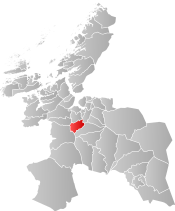Hølonda
Hølonda herred
Høilandet | |
|---|---|
 Sør-Trøndelag within Norway | |
 Hølonda within Sør-Trøndelag | |
| Coordinates: 63°06′49″N 10°01′23″E / 63.11361°N 10.02306°ECoordinates: 63°06′49″N 10°01′23″E / 63.11361°N 10.02306°E | |
| Country | Norway |
| County | Sør-Trøndelag |
| District | Gauldalen |
| Established | 1865 |
| Disestablished | 1 Jan 1964 |
| Administrative centre | Korsvegen |
| Area | |
| • Total | 167 km2 (64 sq mi) |
| *Area at municipal dissolution. | |
| Population (1964) | |
| • Total | 1,428 |
| • Density | 8.6/km2 (22/sq mi) |
| Demonym(s) | hølonding[1] |
| Time zone | UTC+01:00 (CET) |
| • Summer (DST) | UTC+02:00 (CEST) |
| ISO 3166 code | NO-1651 |
| Preceded by | Melhus in 1865 |
| Succeeded by | Melhus in 1964 |
Hølonda is a former municipality in the old Sør-Trøndelag county, Norway. The 167-square-kilometre (64 sq mi) municipality existed from 1865 until its dissolution in 1964. Hølonda encompassed the southwestern part of what is now the municipality of Melhus in Trøndelag county. The municipality was west of the river Gaula. The administrative centre was the village of Korsvegen. The main church for the municipality was Hølonda Church, near Gåsbakken.[2]
History[]
The municipality of Høilandet (later changed to Hølonda) was established in 1865 when it was separated from the old municipality of Melhus. The new municipality had an initial population of 1,818. During the 1960s, there were many municipal mergers across Norway due to the work of the Schei Committee. On 1 January 1964, the neighboring municipalities of Hølonda (population: 1,428), Horg (population: 2,560), Flå (population: 843), Melhus (population: 3,978), and the Langørgen farm (population: 11) in Buvik were all merged to form a new, larger municipality of Melhus.[3]
Name[]
The municipality (originally the parish) was named Hølonda (Old Norse: Høylandir). The first element is høy which means "high" and the last element is the plural form of land which means "land" or "district". Prior to 1889, the name was written Høilandet, then from 1889 until 1931 it was written Hølandet, and then from 1932 until its dissolution in 1964, it was spelled Hølonda.[4]
Government[]
All municipalities in Norway, including Hølanda, are responsible for primary education (through 10th grade), outpatient health services, senior citizen services, unemployment and other social services, zoning, economic development, and municipal roads. The municipality is governed by a municipal council of elected representatives, which in turn elects a mayor.[5]
Municipal council[]
The municipal council (Herredsstyre) of Hølanda was made up of 17 representatives that were elected to four year terms. The party breakdown of the final municipal council was as follows:
| Party Name (in Norwegian) | Number of representatives | |
|---|---|---|
| Labour Party (Arbeiderpartiet) | 6 | |
| Christian Democratic Party (Kristelig Folkeparti) | 2 | |
| Centre Party (Senterpartiet) | 3 | |
| Liberal Party (Venstre) | 6 | |
| Total number of members: | 17 | |
| Party Name (in Norwegian) | Number of representatives | |
|---|---|---|
| Labour Party (Arbeiderpartiet) | 6 | |
| Christian Democratic Party (Kristelig Folkeparti) | 2 | |
| Farmers' Party (Bondepartiet) | 3 | |
| Liberal Party (Venstre) | 6 | |
| Total number of members: | 17 | |
| Party Name (in Norwegian) | Number of representatives | |
|---|---|---|
| Labour Party (Arbeiderpartiet) | 6 | |
| Christian Democratic Party (Kristelig Folkeparti) | 1 | |
| Farmers' Party (Bondepartiet) | 3 | |
| Liberal Party (Venstre) | 6 | |
| Total number of members: | 16 | |
| Party Name (in Norwegian) | Number of representatives | |
|---|---|---|
| Labour Party (Arbeiderpartiet) | 5 | |
| Christian Democratic Party (Kristelig Folkeparti) | 1 | |
| Farmers' Party (Bondepartiet) | 4 | |
| Liberal Party (Venstre) | 6 | |
| Total number of members: | 16 | |
| Party Name (in Norwegian) | Number of representatives | |
|---|---|---|
| Labour Party (Arbeiderpartiet) | 6 | |
| Joint List(s) of Non-Socialist Parties (Borgerlige Felleslister) | 10 | |
| Total number of members: | 16 | |
| Party Name (in Norwegian) | Number of representatives | |
|---|---|---|
| Labour Party (Arbeiderpartiet) | 5 | |
| Joint List(s) of Non-Socialist Parties (Borgerlige Felleslister) | 11 | |
| Total number of members: | 16 | |
See also[]
References[]
- ^ "Navn på steder og personer: Innbyggjarnamn" (in Norwegian). Språkrådet.
- ^ Thorsnæs, Geir, ed. (2017-09-12). "Hølonda – tidligere kommune". Store norske leksikon (in Norwegian). Kunnskapsforlaget. Retrieved 2018-01-28.
- ^ Jukvam, Dag (1999). "Historisk oversikt over endringer i kommune- og fylkesinndelingen" (PDF) (in Norwegian). Statistisk sentralbyrå.
- ^ Rygh, Oluf (1901). Norske gaardnavne: Søndre Trondhjems amt (in Norwegian) (14 ed.). Kristiania, Norge: W. C. Fabritius & sønners bogtrikkeri. p. 267.
- ^ Hansen, Tore, ed. (2016-05-12). "kommunestyre". Store norske leksikon (in Norwegian). Kunnskapsforlaget. Retrieved 2020-02-02.
- ^ "Kommunevalgene og Ordførervalgene 1959" (PDF) (in Norwegian). Oslo: Statistisk sentralbyrå. 1960. Retrieved 2020-04-20.
- ^ "Kommunevalgene og Ordførervalgene 1955" (PDF) (in Norwegian). Oslo: Statistisk sentralbyrå. 1957. Retrieved 2020-04-20.
- ^ "Kommunevalgene og Ordførervalgene 1951" (PDF) (in Norwegian). Oslo: Statistisk sentralbyrå. 1952. Retrieved 2020-04-20.
- ^ "Kommunevalgene og Ordførervalgene 1947" (PDF) (in Norwegian). Oslo: Statistisk sentralbyrå. 1948. Retrieved 2020-04-20.
- ^ "Kommunevalgene og Ordførervalgene 1945" (PDF) (in Norwegian). Oslo: Statistisk sentralbyrå. 1947. Retrieved 2020-04-20.
- ^ "Kommunevalgene og Ordførervalgene 1937" (PDF) (in Norwegian). Oslo: Statistisk sentralbyrå. 1938. Retrieved 2020-04-20.
- Melhus
- Former municipalities of Norway
- 1865 establishments in Norway
- 1964 disestablishments in Norway


